|
|
 |
|
Calanoida ( Order ) |
|
|
|
Arietelloidea ( Superfamily ) |
|
|
|
Heterorhabdidae ( Family ) |
|
|
|
Mesorhabdus ( Genus ) |
|
|
| |
Mesorhabdus brevicaudatus (Wolfenden, 1905) (F,M) | |
| | | | | | | Syn.: | Heterorhabdus brevicaudatus Wolfenden, 1905 a (p.12, Descr.F, figs.F); Sars, 1912 a (p.655); Lysholm & al., 1945 (p.36);
Mesorhabdus annectens Sars, 1905 c (p.9); Pearson, 1906 (p.27);
Mesorhabdus gracilis: Park, 1970 (p.477) | | | | Ref.: | | | Farran, 1908 b (p.67); Sars, 1925 (p.234, figs.F,M); Farran, 1926 (p.285); Rose, 1933 a (p.206, figs.F,M); Jespersen, 1934 (p.108); Lysholm & al., 1945 (p.36); Farran, 1948 d (n°15, p.3, figs.F,M); Tanaka, 1964 a (p.30, figs.F,M, Rem.); Grice & Hulsemann, 1965 (p.224, 247: Rem.); Chihara & Murano, 1997 (p.817, Pl.115: F,M); Ohtsuka & al., 1997 (p.579, figs.F); Park, 2000 (p.29, figs.F,M, Rem.); Vives & Shmeleva, 2007 (p.317, figs.F,M, Rem.) | 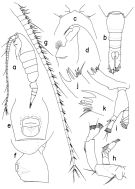 issued from : T. Park in Bull. Scripps Inst. Oceanogr. Univ. California, San Diego, 2000, 31. [p.162, Fig.10]. Female: a, habitus (left side); b, urosome (dorsal); c, d, forehead (dorsal, left, respectively); e, f, genital somite (ventral, left, respectively); g, left A1 (ventral); h, left A2 (posterior); i, left Md (posterior); j, masticatory edge of left Md (posterior); k, masticatory edge of right Md (posterior).
|
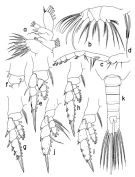 issued from : T. Park in Bull. Scripps Inst. Oceanogr. Univ. California, San Diego, 2000, 31. [p.163, Fig.11]. Female: a, left Mx1 (posterior); b, left Mx2 (posterior); c, right Mxp (anterior); d, second middle marginal seta of Mxp basis; e, P1 (anterior); f, basipod of P1 (posterior); g, P2 (anterior); h, P3 (anterior); i, P4 (anterior); j, P5 (anterior). P1-5 = swimming legs 1-5.
|
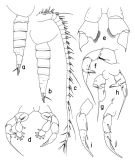 issued from : T. Park in Bull. Scripps Inst. Oceanogr. Univ. California, San Diego, 2000, 31. [p.164, Fig.12]. Male: a, b, urosome (right, left, respectively); c, left A1 (ventral); d, P5 (anterior); e, P5 (with endopods and distal exopodal segments omitted), anterior; f, right P5 (with endopod omitted), anterior; g, exopod of right P5 (posterior); h, idem (tilted counterclockwise); i, j, exopod of left P5 (anterior, posterior, respectively).
|
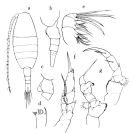 issued from : O. Tanaka in Publs Seto Mar. Biol. Lab., 1964, XII (1). [p.31, Fig.189]. Female: a, habitus (dorsal); b, last thoracic segment and urosome (lateral left side); c, genital somite (lateral left side); d, masticatory edge of Md; e, Mx2; f, P5. Nota: The urosome segments and furca are in the proportional lengths as 35:15:13:14:23 (left) = 100. Male: g, P5. Nota: Right A1 extends about to the end of the 4th urosomal segment. Left A1 forming a grasping organ. According to Sars's figure the Mx2 has only 4 setae on the 1st lobe but in the present specimen the lobe 12 has, beside 3 long setae, 2 spine and a pointed process.
|
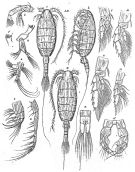 Issued from : G.O. Sars in Résult. Camp. Scient. Prince Albert I, 69, pls.1-127 (1924). [Pl.LXV, figs.1-15]. Female (from aound Azores Islands): 1, habitus (dorsal); 2, idem (lateral left side); 3, A2; 4, left Md; 5, right Md (cutting edge); 6, Mx1; 7, Mx2; 8, Mxp; 9, P1; 10, P2; 11, P3; 12, P5; 13, anal segment and caudal rami (dorsal). Male: 14, habitus (dorsal); 15, P5.
|
 issued from : S. Ohtsuka, H.Y. Soh & S. Nishida in J. Crustacean Biol., 1997, 17 (4). [p.580, Fig.1, D]. Female (from S. Japan): D, mandibular cutting edge. v = ventral tooth; c = central teeth; d, dorsal teeth. Scale bar = 0.100 mm.
|
 issued from : S. Ohtsuka, H.Y. Soh & S. Nishida in J. Crustacean Biol., 1997, 17 (4). [p.583, Fig.4, C, D]. Female (from S. Japan): C, right side of labrum (posterior surface); D, idem : medial pair of gland openings (arrowed). Scale bars : 0.010 mm (C, D).
|
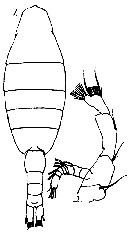 issued from : R.N. Wolfenden in Plankton Studies Part I. Copepoda. 1905 [Pl. IV, 1-2]. As Heterorhabdus brevicaudatus. Female: 1, habitus (dorsal); 2, A2. Nota: Forehead with papilla, but no spine. Endopod of A2 3 times as long as exopod and much wider.
|
 Mesorhabdus brevicaudatus Mesorhabdus brevicaudatus female: 1 - Genital somite without spinules along posterior margin; oral cone with low anterior labral lobe; Coxa of Mxp not with 1+2+3 setae. 2 -Coxa of Mxp with 1+2+2 setae; endopod of Mx1 with 4 setae, exopod with 6+4 setae; Mx2 normally with 6 setae on 1st lobe and 3 setae on 2nd lobe; dorsally, caudal ramus without a large pore close to posterior end. 3 - Dorsally, posterolateral corners of prosome pointing posteriad (Fig.10-b); dorsally, caudal ramus normally wuth a pore at middle; Mx2 with 3 setae on 2nd lobe (Fig.11-b); lateral margin of 1st exopodal segment of P1 not conspicuously bulging (Fig.11-e).
|
 Mesorhabdus brevicaudatus Mesorhabdus brevicaudatus male: 1 - In right P5, 2nd exopodal segment with medial projection at distal end of segment. 2 - Mx1 with 4 setae on endopod and 6+4 seta on exopod; dorsally, caudal ramus without pores on posterior half. 3 - Dorsally, caudal ramus with pores; anteriorly, coxa of P5 with several pores (Fig.12-e). 4 - Dorsally, caudal ramus with a single pore (Fig.11-k); Mx2 with 3 setae on 2nd lobe (Fig.11-b).
| | | | | Compl. Ref.: | | | Sewell, 1948 (p.504); Grice, 1963 a (p.496); Mazza, 1966 (p.72); Grice & Hulsemann, 1967 (p.18); Itoh, 1970 (tab.1); Park, 1970 (p.477); Roe, 1972 (p.277, tabl.1, tabl.2); Deevey & Brooks, 1977 (p.256, tab.2, Station "S"); Vives, 1982 (p.293); Kovalev & Shmeleva, 1982 (p.84); Roe, 1984 (p.358); Lozano Soldevilla & al., 1988 (p.59); Padmavati & al., 1998 (p.347); Lapernat, 2000 (tab.3); Holmes, 2001 (p.17) | | | | NZ: | 9 | | |
|
Distribution map of Mesorhabdus brevicaudatus by geographical zones
|
| | | | | | | | |  Chart of 1996 Chart of 1996 | |
| | | | Loc: | | | Atlant. (S tropical), off NW Cape Verde Is., off Mauritania, Canary Is., off Madeira, off SW Portugal, off W Cape Finisterre, Bay of Biscay, Azores, G. of Mexico, Caribbean Sea, off Bermuda: Station ‘’ S’’ (32°10’N, 64°30’W), Sargasso Sea, S Strait of Davis, off Ireland (S & W), Medit. W (Alboran Sea, Liguro-provençal Channel, Arabian Sea, NE Indian, Japan (Sagami Bay), Pacif (W central tropical), off NE Cook Is., Pacif (NE & SE subtropical), off California | | | | N: | 16 | | | | Lg.: | | | (1) F: 3,5; (38) F: 3,3; M: 3,6; (121) F: 3,38; M: 3,62; (199) F: 3,65-3,34; M: 3,5-3,27; (824) F: 4,24-3,76; M: 3,88-3,6; {F: 3,30-4,24; M: 3,27-3,88} | | | | Rem.: | meso-bathypelagic. After Pearson (1906, p.27): vertical range down to 700 m at SW of Valentia Island (Ireland). Overall Depth Range in Sargasso Sea: 500-1500 m (Deevey & Brooks, 1977, Station "S");
For Itoh (1970 a, fig.2, from co-ordonates) the Itoh's index value of the mandibular gnathobase = 955.
For Park (2000, p.143), this species occurred in all three major oceans and was the most common, representing 44 % of the total found for the genus. M. gracilis and M. paragracilis also occurred in all three major oceans but accounted for only 8 % and 14 % of specimens, respectively;M. angustus and M. poriphorus were found only in Atlantic and Pacific Ocean samples, representing 29 % and 6 %, respectively; M. angustus has been recorded from the Indian Ocean (Sewell, 1932). | | | Last update : 17/10/2017 | |
|
|
 Any use of this site for a publication will be mentioned with the following reference : Any use of this site for a publication will be mentioned with the following reference :
Razouls C., Desreumaux N., Kouwenberg J. and de Bovée F., 2005-2025. - Biodiversity of Marine Planktonic Copepods (morphology, geographical distribution and biological data). Sorbonne University, CNRS. Available at http://copepodes.obs-banyuls.fr/en [Accessed December 04, 2025] © copyright 2005-2025 Sorbonne University, CNRS
|
|
 |
 |










